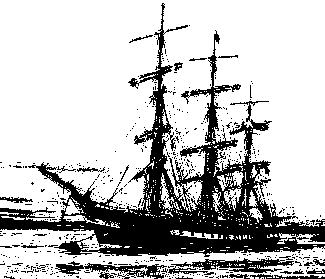 |
FAMOUS SHIPS |
 |
FAMOUS SHIPS |

Her second voyage to Sydney resulted in a much better time of only 86 days. She then again crossed to San Francisco - this time in 61 days - and again sailed for the Lizard with a full cargo from California reaching he destination in 129 days. This was the last time she did this. On her third and subsequent voyages she left the Colonies for home with either wool or wheat; the first time she loaded wool she made the very good time of 86 days to the Start. Between 1884 to 1899 15 voyages were made in the Sydney trade, out with general and home with a wool cargo. Her best outward run was 85 days. Her best homeward run was 83 days. These runs were good, steady work but nothing really exceptional - for an iron ship they were very good, however. Captain Corvasso was succeeded by Captain Smith in the ‘nineties.
In 1899 the ILLAWARRA was chosen as the most suitable ship to become a cadet-training ship. Captain Harwood Barrett was chosen as the new captain, but he died at sea on his first voyage while outward bound for Melbourne. Captain Maitland was ordered to take command. Since he was just married, he took his wife out with him and brought her back home in the ILLAWARRA. He commanded the ship of the next seven years. The cadet system which was used by Devitt & Moore was very expensive but also very good. The cadets themselves lived in luxury, compared with the ordinary sailing-ship apprentice. They were also taught their profession by picked instructors, with the added advantage of usually a start as junior officer in one of the first-class passenger lines as soon as they had passed their second mate’s examination. The boys were divided into two watches, each of two divisions. During the day one division kept the deck, doing all the ordinary ship’s work with the seamen, while the other division attended classes below for navigation, seamanship and nautical astronomy under the instructor. During her years as a cadet ship the ILLAWARRA was diverted from the Sydney run to that of Melbourne. On her first passage to Hobson’s Bay she went from Brixham to Melbourne in 83 days. In 1900 she left London and reached Port Phillip Heads 85 days out. Since she was a cadet ship she was very well manned and always made good passages although they did not push it - her best days run in 1900 was only 301 miles.In 1907 the ILLAWARRA was retired and sold to the Norwegian’s. She loaded wood at Christiania and a deck cargo of deals. Under Captain J. Jobson she made the run to Melbourne in 104 days. The end of this fine old ship came three years later. On February 12th, 1912, she left Leith for Valparaiso. On the way she met with disaster off the Old Head of Kinsale on March 7th and was in a sinking condition, leaking after a violent storm. Her crew was rescued by a British steamer, Bangore Head. Although the report does not say so, it is assumed that she sank off this rugged Irish coast.